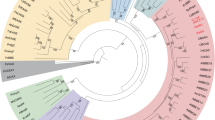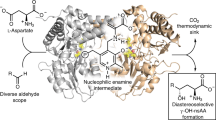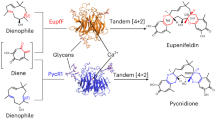Abstract
Natural product chemical diversity is fuelled by the emergence and ongoing evolution of biosynthetic pathways in secondary metabolism1. However, co-evolution of enzymes for metabolic diversification is not well understood, especially at the biochemical level. Here, two parallel assemblies with an extraordinarily high sequence identity from Lyngbya majuscula form a β-branched cyclopropane in the curacin A pathway (Cur), and a vinyl chloride group in the jamaicamide pathway (Jam). The components include a halogenase, a 3-hydroxy-3-methylglutaryl enzyme cassette for polyketide β-branching, and an enoyl reductase domain. The halogenase from CurA, and the dehydratases (ECH1s), decarboxylases (ECH2s) and enoyl reductase domains from both Cur and Jam, were assessed biochemically to determine the mechanisms of cyclopropane and vinyl chloride formation. Unexpectedly, the polyketide β-branching pathway was modified by introduction of a γ-chlorination step on (S)-3-hydroxy-3-methylglutaryl mediated by Cur halogenase, a non-haem Fe(ii), α-ketoglutarate-dependent enzyme2. In a divergent scheme, Cur ECH2 was found to catalyse formation of the α,β enoyl thioester, whereas Jam ECH2 formed a vinyl chloride moiety by selectively generating the corresponding β,γ enoyl thioester of the 3-methyl-4-chloroglutaconyl decarboxylation product. Finally, the enoyl reductase domain of CurF specifically catalysed an unprecedented cyclopropanation on the chlorinated product of Cur ECH2 instead of the canonical α,β C = C saturation reaction. Thus, the combination of chlorination and polyketide β-branching, coupled with mechanistic diversification of ECH2 and enoyl reductase, leads to the formation of cyclopropane and vinyl chloride moieties. These results reveal a parallel interplay of evolutionary events in multienzyme systems leading to functional group diversity in secondary metabolites.
This is a preview of subscription content, access via your institution
Access options
Subscribe to this journal
Receive 51 print issues and online access
$199.00 per year
only $3.90 per issue
Buy this article
- Purchase on Springer Link
- Instant access to full article PDF
Prices may be subject to local taxes which are calculated during checkout




Similar content being viewed by others
References
Fischbach, M. A., Walsh, C. T. & Clardy, J. The evolution of gene collectives: How natural selection drives chemical innovation. Proc. Natl Acad. Sci. USA 105, 4601–4608 (2008)
Vaillancourt, F. H., Yeh, E., Vosburg, D. A., Garneau-Tsodikova, S. & Walsh, C. T. Nature’s inventory of halogenation catalysts: oxidative strategies predominate. Chem. Rev. 106, 3364–3378 (2006)
Fischbach, M. A. & Clardy, J. One pathway, many products. Nature Chem. Biol. 3, 353–355 (2007)
Austin, M. B., O’Maille, P. E. & Noel, J. P. Evolving biosynthetic tangos negotiate mechanistic landscapes. Nature Chem. Biol. 4, 217–222 (2008)
Edwards, D. J. et al. Structure and biosynthesis of the jamaicamides, new mixed polyketide-peptide neurotoxins from the marine cyanobacterium Lyngbya majuscula . Chem. Biol. 11, 817–833 (2004)
Verdier-Pinard, P. et al. Structure-activity analysis of the interaction of curacin A, the potent colchicine site antimitotic agent, with tubulin and effects of analogs on the growth of MCF-7 breast cancer cells. Mol. Pharmacol. 53, 62–76 (1998)
Chang, Z. et al. Biosynthetic pathway and gene cluster analysis of curacin A, an antitubulin natural product from the tropical marine cyanobacterium Lyngbya majuscula . J. Nat. Prod. 67, 1356–1367 (2004)
Blasiak, L. C., Vaillancourt, F. H., Walsh, C. T. & Drennan, C. L. Crystal structure of the non-haem iron halogenase SyrB2 in syringomycin biosynthesis. Nature 440, 368–371 (2006)
Vaillancourt, F. H., Yeh, E., Vosburg, D. A., O’Connor, S. E. & Walsh, C. T. Cryptic chlorination by a non-haem iron enzyme during cyclopropyl amino acid biosynthesis. Nature 436, 1191–1194 (2005)
Vaillancourt, F. H., Yin, J. & Walsh, C. T. SyrB2 in syringomycin E biosynthesis is a nonheme FeII α-ketoglutarate- and O2-dependent halogenase. Proc. Natl Acad. Sci. USA 102, 10111–10116 (2005)
Galonic, D. P., Vaillancourt, F. H. & Walsh, C. T. Halogenation of unactivated carbon centers in natural product biosynthesis: Trichlorination of leucine during barbamide biosynthesis. J. Am. Chem. Soc. 128, 3900–3901 (2006)
Chang, Z. et al. The barbamide biosynthetic gene cluster: a novel marine cyanobacterial system of mixed polyketide synthase (PKS)-non-ribosomal peptide synthetase (NRPS) origin involving an unusual trichloroleucyl starter unit. Gene 296, 235–247 (2002)
Flatt, P. M. et al. Characterization of the initial enzymatic steps of barbamide biosynthesis. J. Nat. Prod. 69, 938–944 (2006)
Galonic, D. P., Barr, E. W., Walsh, C. T., Bollinger, J. M. & Krebs, C. Two interconverting Fe(IV) intermediates in aliphatic chlorination by the halogenase CytC3. Nature Chem. Biol. 3, 113–116 (2007)
Gu, L. C. et al. Metabolic coupling of dehydration and decarboxylation in the curacin A pathway: functional identification of a mechanistically diverse enzyme pair. J. Am. Chem. Soc. 128, 9014–9015 (2006)
Calderone, C. T., Kowtoniuk, W. E., Kelleher, N. L., Walsh, C. T. & Dorrestein, P. C. Convergence of isoprene and polyketide biosynthetic machinery: isoprenyl-S-carrier proteins in the pksX pathway of Bacillus subtilis . Proc. Natl Acad. Sci. USA 103, 8977–8982 (2006)
Calderone, C. T., Iwig, D. F., Dorrestein, P. C., Kelleher, N. L. & Walsh, C. T. Incorporation of nonmethyl branches by lsoprenoid-like logic: Multiple beta-alkylation events in the biosynthesis of myxovirescin A1. Chem. Biol. 14, 835–846 (2007)
Nordling, E., Jornvall, H. & Persson, B. Medium-chain dehydrogenases/reductases (MDR)—Family characterizations including genome comparisons and active site modelling. Eur. J. Biochem. 269, 4267–4276 (2002)
Geders, T. W. et al. Crystal structure of the ECH2 catalytic domain of CurF from Lyngbya majuscula—insights into a decarboxylase involved in polyketide chain β-branching. J. Biol. Chem. 282, 35954–35963 (2007)
Dorrestein, P. C. et al. Facile detection of acyl and peptidyl intermediates on thiotemplate carrier domains via phosphopantetheinyl elimination reactions during tandem mass spectrometry. Biochemistry 45, 12756–12766 (2006)
Kopka, J., Ohlrogge, J. B. & Jaworski, J. G. Analysis of in vivo levels of acyl-thioesters with gas-chromatography mass-spectrometry of the butylamide derivative. Anal. Biochem. 224, 51–60 (1995)
Butcher, R. A. et al. The identification of bacillaene, the product of the PksX megacomplex in Bacillus subtilis . Proc. Natl Acad. Sci. USA 104, 1506–1509 (2007)
El-Sayed, A. K. et al. Characterization of the mupirocin biosynthesis gene cluster from Pseudomonas fluorescens NCIMB 10586. Chem. Biol. 10, 419–430 (2003)
Simunovic, V. et al. Myxovirescin A biosynthesis is directed by hybrid polyketide synthases/nonribosomal peptide synthetase, 3-hydroxy-3-methylglutaryl-CoA synthases, and trans-acting acyltransferases. ChemBioChem 7, 1206–1220 (2006)
Pulsawat, N., Kitani, S. & Nihira, T. Characterization of biosynthetic gene cluster for the production of virginiamycin M, a streptogramin type A antibiotic, in Streptomyces virginiae . Gene 393, 31–42 (2007)
Piel, J. A polyketide synthase-peptide synthetase gene cluster from an uncultured bacterial symbiont of Paederus beetles. Proc. Natl Acad. Sci. USA 99, 14002–14007 (2002)
Piel, J. et al. Antitumor polyketide biosynthesis by an uncultivated bacterial symbiont of the marine sponge Theonella swinhoei . Proc. Natl Acad. Sci. USA 101, 16222–16227 (2004)
Kelly, W. L. et al. Characterization of the aminocarboxycyclopropane-forming enzyme CmaC. Biochemistry 46, 359–368 (2007)
Neumann, C. S. & Walsh, C. T. Biosynthesis of (-)-(1S,2R)-allocoronamic acyl thioester by an FeII-dependent halogenase and a cyclopropane-forming flavoprotein. J. Am. Chem. Soc. 130, 14022–14023 (2008)
Acknowledgements
We thank C. T. Walsh and C. T. Calderone for ACP constructs; S. M. Chernyak, H. Liu and J. Byun for mass spectrometry assistance; P. C. López for NMR assistance; T. M. Ramsey for chiral cyclopronanecarboxylic acid; and D. L. Akey for discussions. This work was supported by grants from the National Institutes of Health (to D.H.S. and J.L.S.), a graduate fellowship from Eli Lilly & Co. and a Rackham Predoctoral Fellowship (to L.G.).
Author Contributions L.G., W.H.G and D.H.S. designed the experiments, analysed data and wrote the paper; L.G. performed the experiments; B.W. and K.H. recorded FTICR mass spectra and analysed the data; T.W.G. and J.L.S. modelled Cur ECH2 structure with the chlorinated substrate and designed site mutagenesis; A.K. and P.W. synthesized the chlorinated butylamide derivatives; R.V.G. and L.G. made Jam ECH1 and ECH2 constructs; W.H.G. provided DNA of Jam enzymes and analysed NMR data for isotope-labelled curacin A.
Author information
Authors and Affiliations
Corresponding author
Supplementary information
Supplementary Information
This file contains Supplementary Methods, Supplementary Figures 1-16 with Legends, Supplementary Tables 1-2 and Supplementary References. (PDF 7311 kb)
Rights and permissions
About this article
Cite this article
Gu, L., Wang, B., Kulkarni, A. et al. Metamorphic enzyme assembly in polyketide diversification. Nature 459, 731–735 (2009). https://doi.org/10.1038/nature07870
Received:
Accepted:
Issue Date:
DOI: https://doi.org/10.1038/nature07870
This article is cited by
-
Initiating polyketide biosynthesis by on-line methyl esterification
Nature Communications (2021)
-
BrtB is an O-alkylating enzyme that generates fatty acid-bartoloside esters
Nature Communications (2020)
-
Structure and mechanism of a dehydratase/decarboxylase enzyme couple involved in polyketide β-methyl branch incorporation
Scientific Reports (2020)
-
Ecogenomics of the Marine Benthic Filamentous Cyanobacterium Adonisia
Microbial Ecology (2020)
-
The hidden enzymology of bacterial natural product biosynthesis
Nature Reviews Chemistry (2019)
Comments
By submitting a comment you agree to abide by our Terms and Community Guidelines. If you find something abusive or that does not comply with our terms or guidelines please flag it as inappropriate.



